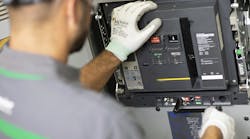In 2018, we are living in a time where technology is rapidly changing before us. Technology that didn’t seem imaginable ten years ago, such as Uber, and digital fingerprint scanning, are now part of our day to day lives. However, much of our equipment supporting new technology is aging, leaving a gap in the infrastructure needed to perform powerful tasks. Without addressing this gap, our potential for new technology is limited. For example, aging circuit breakers, present in almost every application and underpin every business’s work, are operating under tremendous strain.
The longevity of a circuit breaker’s lifecycle depends on several things: periodic maintenance inspection and operation being one of the most important. As technology, reliability, and safety needs have evolved in the energy market, this has created a need to upgrade older, obsolete breakers. Maintaining them has proved challenging and using them can be extremely risky.
There are many misconceptions and realities surrounding obsolete circuit breakers.
The Cost-Effectiveness of a Circuit Breaker
First, many believe maintaining an obsolete circuit breaker is more cost-effective than replacing it. However, it depends on the make and model. If it’s been recently decommissioned, there will be less of an upfront investment, but over time, cost savings will dwindle due to the availability of spare parts that present the biggest cost challenge in maintaining obsolete circuit breakers. Acquiring these spare parts which are necessary to keep the breaker in great condition will become more difficult, and of course, more expensive. There often comes a point in maintaining an obsolete breaker where the most cost-effective course of action is to go with a newer, modernized solution.
The Safety Situation: Refurbished Breakers
While we would always like to think we are purchasing from a reputable seller when buying used goods, this is not always the case. Even if the seller is reliable, using a reconditioned breaker can still introduce risks. Since the equipment is not coming directly from a manufacturer, its traceability is lost, and you don’t really know where the parts or the breaker have been.
Plus, refurbished breakers are not tested to the manufacturer’s standards that require endurance testing for longevity – especially for molded case breakers. The reconditioning industry is only obligated to test to the International Electrical Testing Association (NETA) standards which differs from the manufacturers, which are Underwriters Laboratories or American National Standards Institute (ANSI). Testing to other standards other than manufacturers provide a condition of the equipment at the moment of testing. Although trending of the test data and referring to manufacturers specified service life can allow an attempt to estimate suitable service life it is difficult to ascertain this answer if the equipment has gone beyond its service life. If the equipment doesn’t meet the original requirements, it can lack critical safety features.
Replacing an obsolete breaker means I have to replace all of my equipment
There are several options for replacing an obsolete circuit breaker. Depending on the condition of the infrastructure, the breaker can easily be upgraded either with a direct replacement or retrofit solution. The way that they are designed allows them to fit within the existing equipment with minimal downtime.
Depending on where the breaker is situated and if operational downtime is not a concern, then replacing with new equipment is an excellent option. If the breaker is in a hard to reach location, then bringing in new equipment may prove costly and challenging. In this case, modernization is the best option.
Factors of Breaker Success
- Reliability: When upgrading to newer technology, you automatically increase the facility’s overall reliability. Modern breakers are typically more efficient and have added connectivity and monitoring capabilities that enable predictive maintenance. Facility managers will be able to identify where faults are in the system and course correct before they even become an issue.
- Functionality: In the past breakers were typically designed to be six cycle breakers, whereas today’s breakers are three cycle. By having a longer cycle time it increases the time to clear the fault which could expose the equipment and personnel to longer fault periods if an incident occurred.
- Safety: The newer the breaker is the newer the safety features will be. A new breaker ensures electrical equipment is in compliance with the most current protocols and procedures helping provide employees with safer working conditions when operating the equipment.
There are misconceptions that obsolete breakers can be used without risk. In reality, it can be a gamble. Modernizing and upgrading to new technology can help reduce maintenance costs, enhance safety and provide higher performance.
Knowledge is power when it comes to addressing aging equipment. Whether you decide to replace, modernize or maintain your obsolete circuit breakers, it is important to know the associated risks and benefits. Technology is not slowing down any time soon and it’s best to have equipment prepared.










